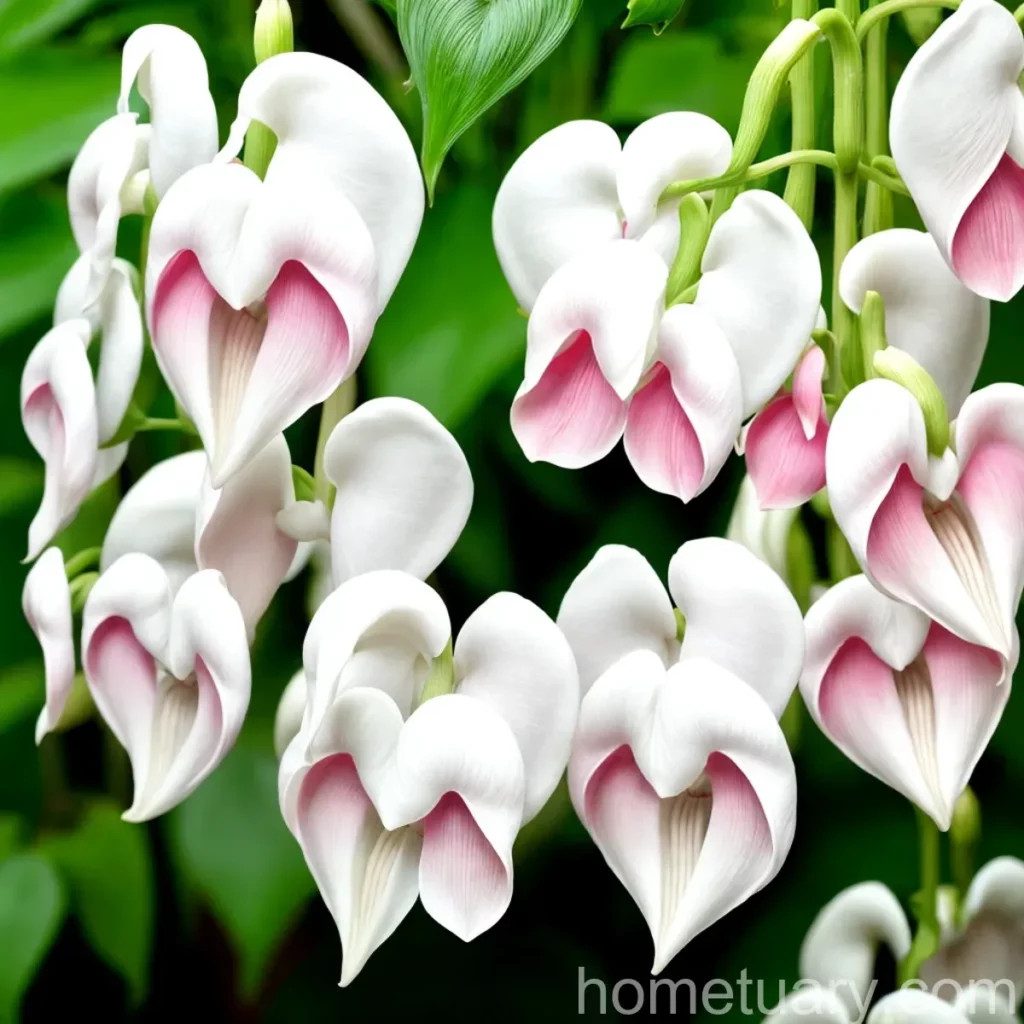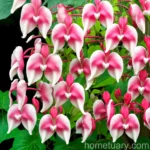Bleeding Heart (Lamprocapnos spectabilis ‘Alba’) – A Delicate Beauty in the Garden
As a plant scientist, I am often fascinated by the diversity and beauty of plants. Among the myriad of plant species that I have encountered, the Bleeding Heart (Lamprocapnos spectabilis ‘Alba’) stands out as a delicate and charming perennial. In this comprehensive guide, we will explore the key features, cultivation, uses, care tips, and interesting facts about the Bleeding Heart plant – an enchanting addition to any garden.
What is the Bleeding Heart (Lamprocapnos spectabilis ‘Alba’)?
The Bleeding Heart, scientifically known as Lamprocapnos spectabilis ‘Alba’, is a herbaceous perennial plant that belongs to the Papaveraceae family. This exquisite plant is native to Siberia, Northern China, Korea, and Japan. The unique name “Bleeding Heart” is derived from the shape of its flowers, which resemble tiny pink or white hearts that appear to be “bleeding” from the tip.
The ‘Alba’ variety of Bleeding Heart is particularly captivating due to its pure white heart-shaped flowers, which differentiate it from the more common pink-flowered variety.
Key Takeaways – Bleeding Heart (Lamprocapnos spectabilis ‘Alba’)
Before delving into the details of its cultivation and care, let’s outline the key takeaways about the Bleeding Heart plant:
- Plant Name: Bleeding Heart (Lamprocapnos spectabilis ‘Alba’)
- Common Names: White Bleeding Heart
- Family: Papaveraceae
- Native Habitat: Siberia, Northern China, Korea, Japan
- Flower Color: White
- Distinctive Feature: Heart-shaped flowers
- Cultivation: Perennial
- Variety: ‘Alba’
Now, let’s explore the essential aspects of cultivating and caring for this captivating plant.
Culture of Bleeding Heart (Lamprocapnos spectabilis ‘Alba’)
Understanding the culture of the Bleeding Heart plant is crucial for its successful growth and development.
Uses
The Bleeding Heart (Lamprocapnos spectabilis ‘Alba’) serves several purposes in gardening and landscaping:
- Ornamental Plant: With its elegant and distinctive flowers, the Bleeding Heart is primarily grown for its ornamental value. The ‘Alba’ variety, in particular, adds a touch of elegance to gardens with its white blooms.
- Shade Garden: Due to its preference for partial to full shade, the Bleeding Heart is an excellent choice for shaded gardens and woodland landscapes.
- Cut Flowers: The charming heart-shaped flowers make beautiful additions to floral arrangements, adding a touch of romance to bouquets and centerpieces.
Water
Proper watering is essential for the health and vitality of the Bleeding Heart plant. Here are some key considerations for watering this delicate perennial:
- Moist, Well-Drained Soil: The Bleeding Heart thrives in consistently moist, well-drained soil. It is important to ensure that the plant does not experience prolonged dry periods, especially during the hot summer months.
- Mulching: Applying a layer of organic mulch around the base of the plant helps retain soil moisture, which is beneficial for the Bleeding Heart’s growth and development.
Sunlight
The Bleeding Heart is known for its preference for partial to full shade, making it an ideal choice for shaded garden areas. When selecting a location for planting, consider the following sunlight requirements:
- Partial Shade: The Bleeding Heart thrives in partial shade, particularly in locations with filtered sunlight or dappled shade.
- Avoid Harsh Sunlight: Direct exposure to intense sunlight, especially during the hottest part of the day, can cause the delicate foliage to scorch. Therefore, it is essential to provide adequate shade for the plant, especially in regions with hot summers.
Fertilizer
Proper fertilization is crucial for promoting healthy growth and abundant flowering in the Bleeding Heart plant. Here are some useful tips for fertilizing this enchanting perennial:
- Organic Matter: Incorporating organic matter such as well-rotted compost or leaf mold into the soil at the time of planting provides essential nutrients and improves soil structure.
- Balanced Fertilizer: During the growing season, applying a balanced, slow-release fertilizer with a higher phosphorus content can encourage robust growth and prolific flowering. It is important to follow the manufacturer’s recommendations for application rates and frequency.
Soil
Understanding the soil preferences of the Bleeding Heart plant is essential for creating an optimal growing environment. Consider the following soil-related aspects when cultivating this delicate beauty:
- Moist, Loamy Soil: The Bleeding Heart thrives in rich, moist, and well-drained loamy soil. The addition of organic matter such as compost or peat moss can improve soil moisture retention and fertility.
- pH Level: The ideal soil pH for the Bleeding Heart ranges from slightly acidic to neutral (pH 6.0 to 7.0). Conducting a soil test can help determine the pH level and make any necessary adjustments to create a favorable growing environment for the plant.
Pruning
Pruning plays a crucial role in maintaining the health, vigor, and aesthetic appeal of the Bleeding Heart plant. Here are some essential tips for proper pruning:
- Spring Pruning: In late spring or early summer, after the plant has finished flowering, remove any faded or yellowing foliage to tidy up the appearance of the plant.
- Rejuvenation Pruning: Performing rejuvenation pruning by cutting back the foliage and stems after the plant goes dormant in the fall can promote vigorous regrowth and enhance the plant’s overall performance.
Propagation
To propagate the Bleeding Heart (Lamprocapnos spectabilis ‘Alba’), several methods can be employed to create new plants. Here are some common propagation techniques:
- Division: Dividing mature plants in early spring or fall is a popular method for propagating the Bleeding Heart. Carefully lift the plant from the ground, divide the clumps into smaller sections, and replant them in suitable locations.
- Seed Propagation: Collecting and sowing seeds from mature Bleeding Heart plants can also be a rewarding propagation method. However, it is important to note that seed-grown Bleeding Heart plants may not immediately resemble the parent plant, as they may exhibit genetic variations.
Container Popularity
The Bleeding Heart (Lamprocapnos spectabilis ‘Alba’) is also well-suited for container cultivation, allowing individuals with limited garden space to enjoy its charming beauty. Consider the following points when growing the Bleeding Heart in containers:
- Container Size: Select a spacious container with adequate drainage holes to accommodate the plant’s root system and provide room for growth.
- Well-Draining Soil: Use a high-quality, well-draining potting mix to ensure proper soil moisture levels and prevent waterlogged conditions.
Common Diseases
Despite its enchanting appearance, the Bleeding Heart plant is susceptible to certain diseases that can affect its health and vigor. Some common diseases that may impact the Bleeding Heart include:
- Powdery Mildew: This fungal disease can manifest as powdery, white patches on the leaves, leading to reduced photosynthetic activity and overall decline in plant health.
- Leaf Spot: Leaf spot diseases can cause the development of dark lesions on the foliage, potentially leading to leaf drop and diminished plant aesthetics.
Disease Diagnosis
Early diagnosis and prompt management of diseases are crucial for preserving the health and beauty of the Bleeding Heart plant. When identifying potential diseases, consider the following diagnostic measures:
- Visual Symptoms: Pay close attention to the foliage, stems, and flowers for any abnormal discoloration, spots, or abnormal growth patterns.
- Consultation: If you suspect disease presence on your Bleeding Heart plant, consult with a local plant pathology expert or extension service to obtain accurate diagnoses and treatment recommendations.
Common Pests
In addition to diseases, the Bleeding Heart (Lamprocapnos spectabilis ‘Alba’) may also attract certain pests that can pose a threat to its well-being. Some common pests to be mindful of include:
- Aphids: These tiny, sap-sucking insects can colonize the tender new growth of the Bleeding Heart, causing distortion and damage to the foliage.
- Slugs and Snails: These grazing pests are known to feed on the leaves of the Bleeding Heart, leaving behind characteristic irregular holes and damage.
Plant Name: “bleeding heart (Lamprocapnos spectabilis ‘Alba’)
Botanist’s Tips
As a plant scientist, I would like to offer some additional tips for cultivating and caring for the Bleeding Heart (Lamprocapnos spectabilis ‘Alba’):
- Mulching: Applying a layer of organic mulch around the base of the plant can help conserve soil moisture, regulate soil temperature, and suppress weed growth.
- Companion Plants: Pairing the Bleeding Heart with shade-loving companions such as hostas, ferns, and astilbes can create a visually stunning and cohesive woodland garden display.
- Seasonal Interest: Even when not in bloom, the finely cut, fern-like foliage of the Bleeding Heart adds visual interest to shaded garden areas throughout the growing season.
Fun Facts
To further appreciate the charm and allure of the Bleeding Heart plant, here are some intriguing and delightful fun facts about this captivating perennial:
- The Bleeding Heart plant is often associated with romantic symbolism, representing love and compassion in flower language and Victorian floral symbolism.
- In certain cultures, the Bleeding Heart plant is believed to possess medicinal properties and has been historically used in traditional herbal remedies.
- The Bleeding Heart plant can attract various pollinators, including bees and butterflies, contributing to the ecological value of garden landscapes.
Links to External Resources
To deepen your understanding of the Bleeding Heart (Lamprocapnos spectabilis ‘Alba’) and explore additional information, here are some valuable external resources:
- Royal Horticultural Society – Bleeding Heart Plant Guide
- The Spruce – Growing Bleeding Heart Plants
- University of California Integrated Pest Management – Bleeding Heart Diseases
- AmericanHort – Bleeding Heart Care and Maintenance
In conclusion, the Bleeding Heart (Lamprocapnos spectabilis ‘Alba’) is a remarkable plant that captivates with its elegant, heart-shaped blooms and delicate foliage. By understanding its cultivation, care requirements, and fascinating attributes, we can truly appreciate and cherish this enchanting perennial in garden and landscape settings. I hope this comprehensive guide has provided valuable insights into the world of the Bleeding Heart plant and inspired a deeper appreciation for its timeless beauty.
Happy gardening!
This blog post offers a comprehensive guide to the Bleeding Heart (Lamprocapnos spectabilis ‘Alba’) plant, covering its culture, uses, care tips, and fascinating attributes. The extensive information provided in this article aims to serve as a valuable resource for gardening enthusiasts and plant lovers alike.
For the complete list of references and resources, please refer to the links provided in the article.















